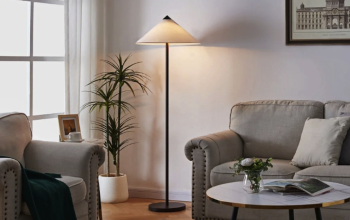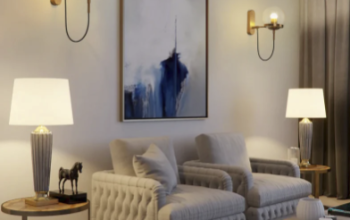When it comes to creating a comfortable and inviting home, lighting plays a crucial role. The right lighting can transform a space, setting the mood, enhancing productivity, and improving overall well-being. It is not just about having enough light in a room; it is about choosing the right lighting fixtures and bulbs that complement the style and function of the space.
Lighting has a significant impact on our mood and emotions. Bright, natural light can boost our energy levels and improve our mood, while soft, warm light can create a cozy and relaxing atmosphere. In addition to affecting our mood, lighting also affects our productivity. Proper lighting in work areas can reduce eye strain and fatigue, allowing us to focus better and be more productive.
Choosing the right lighting fixtures and bulbs is essential for achieving the desired effect in a room. Different types of fixtures serve different purposes and can create different atmospheres. From ceiling fixtures like chandeliers and pendants to wall fixtures like sconces and vanity lights, each type of fixture has its own unique qualities that can enhance the overall design of a space.
Types of Lighting Fixtures: A Comprehensive Guide
Ceiling fixtures are often the main source of light in a room and can make a significant impact on the overall design. Chandeliers are elegant and luxurious, making them perfect for formal dining rooms or grand entryways. Pendants are versatile and can be used in various spaces, from kitchens to bedrooms. Flush mounts are ideal for low ceilings or spaces where a sleek and minimalistic look is desired.
Wall fixtures, such as sconces, picture lights, and vanity lights, provide both functional and decorative lighting. Sconces can be used to create ambient lighting or to highlight architectural features. Picture lights are designed specifically to illuminate artwork and add drama to a space. Vanity lights are essential for proper lighting in bathrooms and dressing areas.
Floor and table lamps are not only functional but also add style and personality to a room. Task lamps are perfect for reading or working at a desk, while arc lamps can provide overhead lighting in a living room or bedroom. Table lamps can be used as accent lighting or to create a cozy atmosphere in a bedroom or living room.
Specialty fixtures, such as track lighting kaybova and under-cabinet lighting, serve specific purposes. Track lighting is versatile and can be used to highlight artwork or architectural features. Under-cabinet lighting is essential in kitchens for task lighting and creating a warm and inviting atmosphere.
Choosing the Right Bulbs: LED, CFL, or Incandescent?
When it comes to choosing bulbs, there are several options available, each with its own pros and cons. LED bulbs are energy-efficient, long-lasting, and come in a variety of color temperatures. They are more expensive upfront but can save money in the long run due to their energy efficiency. CFL bulbs are also energy-efficient but take some time to warm up and may not be suitable for dimming. Incandescent bulbs are the least energy-efficient but provide warm and natural light.
When choosing bulbs, it is important to consider factors such as color temperature and lumens. Color temperature refers to the warmth or coolness of the light emitted by a bulb. Bulbs with a lower color temperature (around 2700K) emit warm light, while bulbs with a higher color temperature (around 5000K) emit cool light. Lumens measure the brightness of a bulb, with higher lumens indicating brighter light.
It is also important to select the right bulbs for different fixtures and rooms. For example, in kitchens and bathrooms where task lighting is essential, it is recommended to use bright white or daylight bulbs with high lumens. In bedrooms and living rooms where a cozy atmosphere is desired, it is best to use warm white bulbs with lower lumens.
Layering Light: How to Create a Balanced Lighting Scheme
Creating a balanced lighting scheme involves layering different types of light to achieve the desired effect. Ambient lighting provides overall illumination and can be achieved through ceiling fixtures or natural light. Task lighting is focused and provides light for specific activities, such as reading or cooking. Accent lighting is used to highlight specific objects or areas in a room, such as artwork or architectural features.
To create a well-lit and visually appealing space, it is important to combine these different types of lighting. For example, in a living room, ambient lighting can be provided by a chandelier or pendant, while task lighting can be achieved through floor or table lamps. Accent lighting can be used to highlight artwork or architectural features.
Dimmers and smart lighting are also essential tools for controlling the intensity and color of light. Dimmers allow you to adjust the brightness of a light fixture, creating different moods and atmospheres in a room. Smart lighting systems, such as those controlled by smartphones or voice assistants, allow you to control the color and intensity of light with ease.
Lighting for Different Rooms: Tips and Tricks
Each room in the house has its own unique lighting needs and requirements. In the bedroom, it is important to create a cozy and relaxing atmosphere. This can be achieved through warm white bulbs and soft ambient lighting. Task lighting can be provided by bedside lamps or wall-mounted sconces for reading.
In the kitchen, proper task lighting is essential for cooking and food preparation. Bright white or daylight bulbs with high lumens are recommended for under-cabinet lighting and pendant lights above the kitchen island. Ambient lighting can be achieved through recessed ceiling lights or track lighting.
In the living room, a combination of ambient, task, and accent lighting is important for creating a versatile space. Ambient lighting can be provided by ceiling fixtures or natural light, while task lighting can be achieved through floor or table lamps. Accent lighting can be used to highlight artwork or architectural features.
Accent Lighting: Adding Drama and Interest to Your Space

Accent lighting is an important element in interior design as it adds drama and visual interest to a space. It is used to highlight specific objects or areas in a room, such as artwork, plants, or architectural features. Accent lighting can be achieved through various fixtures, such as track lighting, picture lights, or wall-mounted sconces.
When using accent lighting, it is important to consider the placement and direction of the light. Uplighting, where the light is directed upwards towards a wall or ceiling, can create a soft and diffused glow. Downlighting, where the light is directed downwards, can create a more focused and dramatic effect.
Task Lighting: Illuminating Work Areas and Reading Nooks
Task lighting is essential for creating a functional and productive space. It provides focused light for specific activities, such as reading, cooking, or working at a desk. Task lighting fixtures should be positioned to minimize shadows and glare.
When choosing task lighting fixtures and bulbs, it is important to consider the specific needs of the work area. For example, in a home office, a desk lamp with adjustable brightness and color temperature is ideal for reducing eye strain. In a reading nook, a floor lamp with a warm white bulb provides cozy and comfortable lighting.
Mood Lighting: Creating Ambiance with Dimmers and Color Temperature
Mood lighting is all about creating different atmospheres in a room by adjusting the intensity and color of light. Dimmers are essential tools for controlling the brightness of light fixtures and creating different moods. By dimming the lights, you can create a cozy and intimate atmosphere.
Color temperature also plays a significant role in setting the mood of a room. Warm white light (around 2700K) creates a cozy and relaxing atmosphere, while cool white light (around 5000K) creates a more energizing and vibrant atmosphere. By using bulbs with different color temperatures, you can create different moods in different areas of a room.
Smart lighting systems are also becoming increasingly popular for creating mood lighting. These systems allow you to control the color and intensity of light with ease, using your smartphone or voice commands. You can create preset lighting scenes for different activities or moods, such as movie night or dinner party.
Energy Efficiency: Saving Money and the Environment
Using energy-efficient lighting fixtures and bulbs not only saves money on electricity bills but also helps protect the environment. LED bulbs are the most energy-efficient option, using up to 80% less energy than traditional incandescent bulbs. They also last significantly longer, reducing the need for frequent bulb replacements.
In addition to using energy-efficient bulbs, there are other ways to reduce energy consumption and save money. Using natural light whenever possible can help reduce the need for artificial lighting. Installing motion sensors or timers in rooms that are frequently unoccupied can also help save energy.
When choosing lighting fixtures, it is important to look for eco-friendly options that are made from sustainable materials and have minimal impact on the environment. There are many stylish and sustainable lighting options available, such as fixtures made from recycled materials or those powered by solar energy.
Installation and Maintenance: DIY or Professional Help?
Installing lighting fixtures and bulbs safely and correctly is essential for both functionality and safety. While some tasks can be done as DIY projects, others may require the help of a professional electrician. It is important to have a basic understanding of electrical wiring and safety precautions before attempting any electrical work.
When it comes to maintenance, there are some basic tasks that can be performed by homeowners, such as replacing bulbs or cleaning fixtures. However, more complex tasks, such as rewiring or repairing fixtures, should be left to professionals. Regular maintenance, such as cleaning fixtures and checking for loose connections, is important for ensuring the longevity and safety of lighting systems.
In conclusion, lighting plays a crucial role in home decor and overall well-being. The right lighting fixtures, bulbs, and color temperature can transform a space, creating a comfortable and inviting atmosphere. By layering different types of light and using dimmers and smart lighting, you can create a balanced lighting scheme that enhances the functionality and aesthetics of a room.
Energy-efficient lighting options not only save money on electricity bills but also help protect the environment. By choosing eco-friendly lighting fixtures and bulbs and practicing proper installation and maintenance, you can reduce energy consumption and minimize your carbon footprint.
Whether you are looking to create a cozy bedroom, a functional kitchen, or a relaxing living room, understanding the different types of lighting fixtures and bulbs available is essential. By considering factors such as color temperature, lumens, and the specific needs of each room, you can create a well-lit and visually appealing space that enhances your mood, productivity, and overall well-being.



